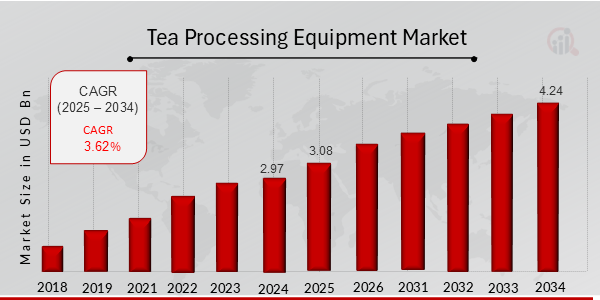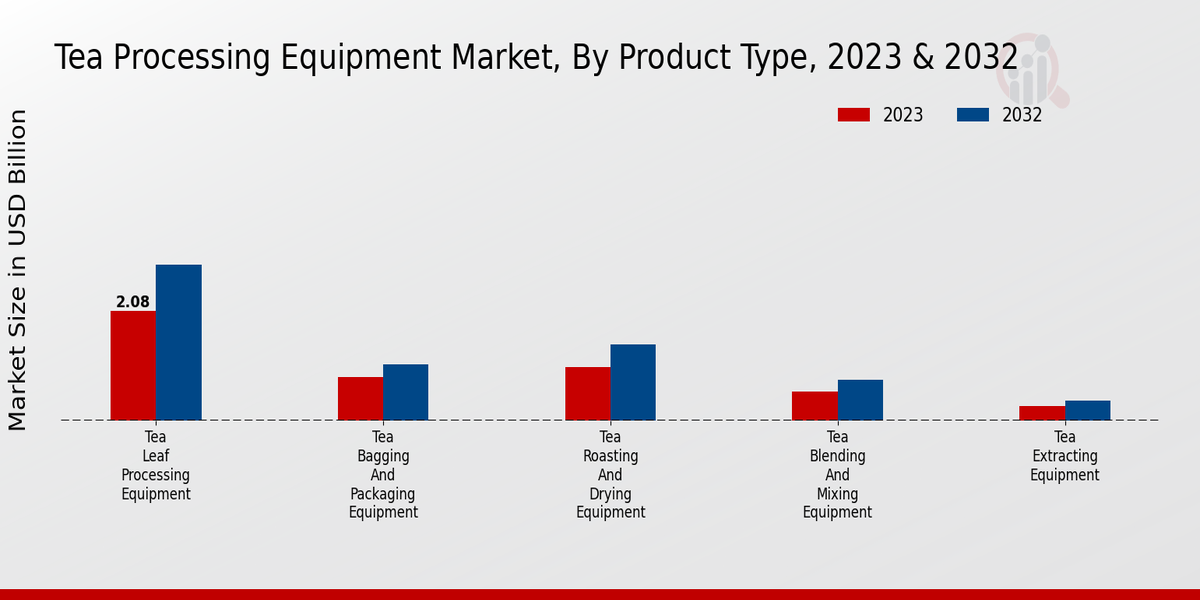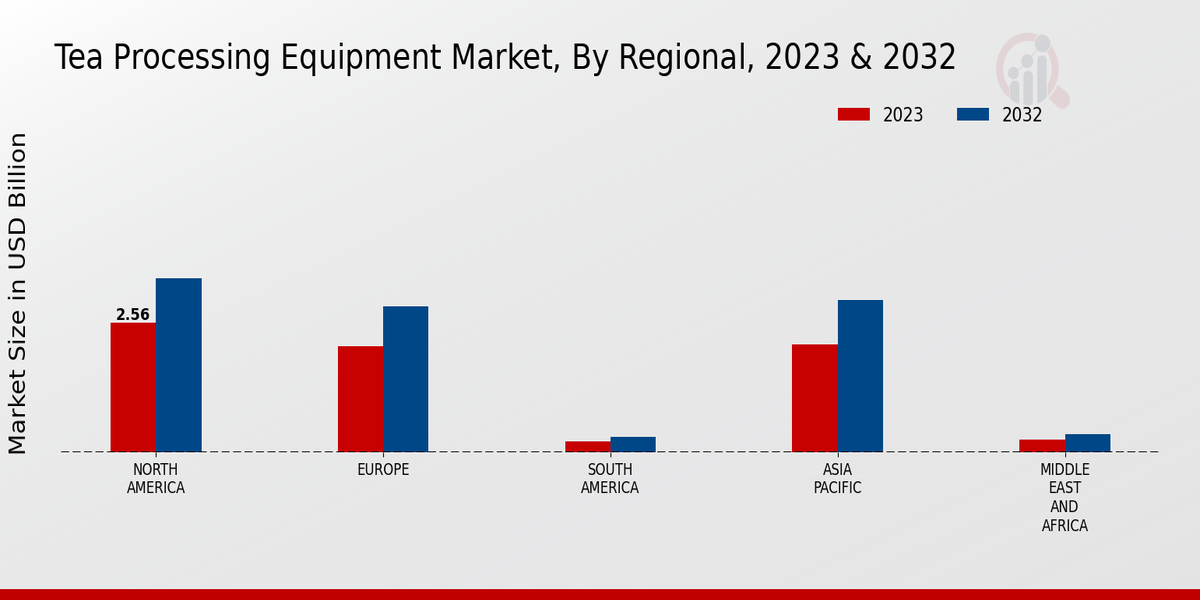Tea Processing Equipment Market Overview:
As per MRFR analysis, the Tea Processing Equipment Market Size was estimated at 2.97 (USD Billion) in 2024. The Tea Processing Equipment Market Industry is expected to grow from 3.08 (USD Billion) in 2025 to 4.24 (USD Billion) till 2034, at a CAGR (growth rate) is expected to be around 3.62% during the forecast period (2025 - 2034).
Key Tea Processing Equipment Market Trends Highlighted
The global tea processing equipment market is anticipated to witness substantial growth in the forthcoming years, driven by rising consumer demand for premium and specialty teas. Automation and advanced technologies are shaping the industry, with equipment manufacturers integrating artificial intelligence and predictive analytics to enhance efficiency and optimize operations.
Additionally, the growing popularity of e-commerce platforms is creating new opportunities for tea processors and equipment suppliers to reach a wider customer base. Sustainability and environmental concerns are also influencing market trends, leading to the adoption of eco-friendly and energy-efficient equipment. Moreover, the increasing consumption of tea in emerging markets presents significant growth opportunities for market players

Source: Primary Research, Secondary Research, MRFR Database and Analyst Review
Tea Processing Equipment Market Drivers
Rising Demand for Value-Added Tea Products
Nowadays, consumers are willing to buy tea products that can cater to some value-added benefits, for example, superior flavor and aroma or better health benefits. Ultimately, tea processing equipment combines several of these characteristics for the production of value-added tea products. For example, processing equipment is used for producing micro-encapsulated tea powders, which have better possibilities of preserving the flavor and aroma of the tea in comparison with other processing techniques.At the same time, growing market demand for functional teas also stimulates the development of processing equipment. The production of such teas is an innovative process, meaning that specialized equipment is needed for the purpose.
Technological Advancements in Tea Processing
The Global Tea Processing Equipment Market Industry is seeing a lot of technological advancements that are making tea processing operations more efficient and productive. For example, automated tea processing lines are being adopted which make the process streamlined and improve the product consistencies while cutting the labor cost for the producers as well. In addition to that, the use of advanced sensors and control systems has made the process of monitoring tea processing parameters in real-time possible and easy. This not only improves the quality of the tea produced but also minimizes the waste produced from the processes.
Expansion of Tea Production in Emerging Markets
The expansion of tea cultivation in emerging markets, such as Asia and Africa, is creating new opportunities for the Global Tea Processing Equipment Market Industry. These regions have favorable climatic conditions for tea production and are experiencing increasing demand for tea both domestically and internationally. As a result, tea producers in these regions are investing in tea processing equipment to meet the growing demand and improve the quality of their products.
Tea Processing Equipment Market Segment Insights:
Tea Processing Equipment Market Product Type Insights
The global Tea Processing Equipment Market is segmented by Product Type into Tea Leaf Processing Equipment, Tea Bagging and Packaging Equipment, Tea Roasting and Drying Equipment, Tea Blending and Mixing Equipment, and Tea Extracting Equipment. Tea Leaf Processing Equipment accounted for the largest share of the global Tea Processing Equipment Market in 2023 and is projected to continue to dominate the market throughout the forecast period. This is primarily due to the increasing demand for high-quality tea leaves, which has led to the adoption of advanced tea leaf processing equipment.Tea Bagging and Packaging Equipment is another significant segment of the global Tea Processing Equipment Market. The growing popularity of tea bags has driven the demand for efficient and cost-effective tea bagging and packaging equipment. Tea Roasting and Drying Equipment is used to roast and dry tea leaves, which enhances their flavor and aroma. The rising consumption of premium teas has led to an increased demand for tea roasting and drying equipment. Tea Blending and Mixing Equipment is used to create custom tea blends that cater to the specific preferences of consumers.The growing popularity of flavored teas has fueled the demand for tea blending and mixing equipment. Tea Extracting Equipment is used to extract tea essence, which is used in the production of tea extracts and other tea-based products. The increasing demand for tea extracts in the food and beverage industry is expected to drive the growth of the tea-extracting equipment market. Overall, the global Tea Processing Equipment Market is expected to witness steady growth in the coming years, driven by the increasing demand for high-quality tea products and the adoption of advanced tea processing technologies.
Source: Primary Research, Secondary Research, MRFR Database and Analyst Review
Tea Processing Equipment Market Capacity Insights
The Global Tea Processing Equipment Market is segmented by capacity into small-scale (less than 100 kg/hr), medium-scale (100-500 kg/hr), and large-scale (more than 500 kg/hr). The large-scale segment held the largest market share in 2023 and is projected to continue to dominate the market during the forecast period. This is due to the increasing demand for large-scale tea processing equipment from large tea producers, who require high-capacity equipment to meet their production targets. The small-scale segment is expected to witness the highest growth rate during the forecast period, owing to the growing popularity of small-scale tea production in developing countries.
Tea Processing Equipment Market Automation Level Insights
The level of automation in tea processing equipment is a key factor in determining the efficiency and cost-effectiveness of tea production. Manual tea processing equipment requires significant labor input, while semi-automated and fully automated equipment can reduce labor costs and increase productivity. The increasing popularity of specialty teas and the rising consumption of tea in emerging markets are also contributing to market growth. In terms of automation level, the semi-automated segment is expected to account for the largest share of the market in 2023. Semi-automated equipment offers a balance between labor costs and productivity, making it a popular choice for tea producers. However, the fully automated segment is expected to grow at a faster pace during the forecast period as tea producers seek to further increase efficiency and reduce labor costs.
Tea Processing Equipment Market Application Insights
The global tea processing equipment market is segmented on the basis of application into green tea processing, black tea processing, white tea processing, oolong tea processing, and herbal tea processing. Among these segments, black tea processing accounts for the largest market share, owing to the high demand for black tea worldwide. The rising popularity of green tea and herbal tea is expected to drive the growth of the green tea processing and herbal tea processing segments in the coming years. The increasing adoption of advanced tea processing technologies, such as automated tea processing lines and continuous tea fermentation systems, is also driving the growth of the tea processing equipment market. The market is expected to reach a value of USD 3.06 billion by 2024, exhibiting a CAGR of 4.2% during the forecast period.
Tea Processing Equipment Market Regional Insights
The Global Tea Processing Equipment Market segmentation by region provides insights into the geographical distribution of the market. North America is expected to dominate the global tea processing equipment market in 2023, with a market share of around 35%. The region's large tea-producing countries, such as the United States and Canada, contribute to the high demand for tea processing equipment. Europe is another major region in the global tea processing equipment market, with a market share of around 25%. The region's established tea industry and growing demand for premium teas are driving the market growth.APAC is a rapidly growing region in the global tea processing equipment market, with a market share of around 20%. The region's increasing tea consumption and expanding tea industry are fueling the market growth. South America and MEA are expected to witness steady growth in the global tea processing equipment market over the forecast period. The growing tea production and consumption in these regions are expected to drive the market growth.
Source: Primary Research, Secondary Research, MRFR Database and Analyst Review
Tea Processing Equipment Market Key Players And Competitive Insights:
Major players in the Tea Processing Equipment Market are constantly striving to gain a competitive edge by investing in research and development. This has led to the introduction of innovative technologies and equipment that can efficiently process tea leaves and produce high-quality tea products. Leading Tea Processing Equipment Market players are also focusing on expanding their global presence and establishing strategic partnerships to increase their market share. The Tea Processing Equipment Market industry is highly fragmented, with a large number of small and medium-sized enterprises operating alongside a few large multinational corporations. These companies are engaged in intense competition to gain market share and establish themselves as leaders in the industry.Buhler is a leading provider of tea processing equipment and solutions. The company offers a wide range of products, including tea dryers, tea blenders, and tea bagging machines. Buhler has a strong global presence and serves customers in over 100 countries. The company is committed to innovation and continuously invests in research and development to improve its products and services. Buhler's strong financial performance and customer-centric approach have contributed to its success in the Tea Processing Equipment Market.Another key player in the Tea Processing Equipment Market is TMCI Padovan. The company specializes in the design and manufacture of tea-processing machinery. TMCI Padovan offers a comprehensive range of products, including tea crushers, tea cutters, and tea sifters. The company has a strong global presence and serves customers in over 50 countries. TMCI Padovan is known for its high-quality products and excellent customer service. The company's commitment to sustainability and environmental protection has also earned it a strong reputation in the industry.
Key Companies in the Tea Processing Equipment Market Include:
- Buhler Group
- Shanghai Jiahua Industry
- TeaTech
- Sitma Machinery
- Takhi Machinery
- Rotex Group
- TMC Industries
- Jiangsu Lehu Machinery
- Yingkou Tianhua Light Industry Machinery
- CHTC Jiansu Machinery Group
- Harbin Aokun Group
- Ishida Co.
- Fuchuan Group
- GEA Group
Tea Processing Equipment Market Industry Developments
The global tea processing equipment market is anticipated to exhibit a steady growth trajectory, reaching a value of USD 4.24 billion by 2034, expanding at a CAGR of 3.62% from 2025 to 2034. The rising demand for tea, coupled with the increasing adoption of advanced technologies in tea processing, is driving market growth. The growing popularity of specialty teas and the expansion of the tea industry in emerging markets are further contributing to the market's expansion.Recent developments in the market include the introduction of automated tea processing lines, which enhance efficiency and reduce labor costs. Additionally, the integration of sensors and IoT devices into tea processing equipment allows for real-time monitoring and control of the process, improving quality and consistency. Innovations in packaging technologies, such as biodegradable and sustainable packaging solutions, are also gaining traction in the market.Key players in the global tea processing equipment market include Buhler Group, Harpak-Ulma, and GEA Group. These companies are focusing on strategic partnerships, technological advancements, and geographic expansion to maintain their competitive edge.
Tea Processing Equipment Market Segmentation Insights
Tea Processing Equipment Market Product Type Outlook
- Tea Leaf Processing Equipment
- Tea Bagging and Packaging Equipment
- Tea Roasting and Drying Equipment
- Tea Blending and Mixing Equipment
- Tea Extracting Equipment
Tea Processing Equipment Market Capacity Outlook
- Small-Scale (Less than 100 kg/hr)
- Medium-Scale (100-500 kg/hr)
- Large-Scale (More than 500 kg/hr)
Tea Processing Equipment Market Automation Level Outlook
- Manual
- Semi-Automated
- Fully Automated
Tea Processing Equipment Market Application Outlook
- Green Tea Processing
- Black Tea Processing
- White Tea Processing
- Oolong Tea Processing
- Herbal Tea Processing
Tea Processing Equipment Market Regional Outlook
- North America
- Europe
- South America
- Asia Pacific
- Middle East and Africa
| Report Attribute/Metric |
Details |
|
Market Size 2024
|
2.97 (USD Billion)
|
|
Market Size 2025
|
3.08 (USD Billion)
|
|
Market Size 2034
|
4.24 (USD Billion)
|
|
Compound Annual Growth Rate (CAGR)
|
3.62% (2025 - 2034)
|
|
Report Coverage
|
Revenue Forecast, Competitive Landscape, Growth Factors, and Trends
|
|
Base Year
|
2024
|
|
Market Forecast Period
|
2025 - 2034
|
|
Historical Data
|
2019 - 2023
|
| Market Forecast Units |
USD Billion |
| Key Companies Profiled |
Buhler Group, Shanghai Jiahua Industry, TeaTech, Sitma Machinery, Takhi Machinery, Rotex Group, TMC Industries, Jiangsu Lehu Machinery, Yingkou Tianhua Light Industry Machinery, CHTC Jiansu Machinery Group, Harbin Aokun Group, Ishida Co., Fuchuan Group, GEA Group |
| Segments Covered |
Product Type, Capacity, Automation Level, Application, Regional |
| Key Market Opportunities |
Increased tea consumption technological advancements, rising demand for healthy beverages, growing tea industry in emerging markets, and government support for tea cultivation |
| Key Market Dynamics |
Rising demand for green and organic tea Technological advancements Growing tea production Increasing health consciousness Expanding tea consumption in emerging markets |
| Countries Covered |
North America, Europe, APAC, South America, MEA |
Frequently Asked Questions (FAQ) :
The Global Tea Processing Equipment Market is projected to reach an overall valuation of 3.08 billion USD in 2025.
The Global Tea Processing Equipment Market is expected to exhibit a CAGR of 3.62% during the forecast period from 2025 to 2034.
By 2034, the Global Tea Processing Equipment Market is anticipated to reach an overall valuation of 4.24 billion USD.
North America is expected to dominate the Global Tea Processing Equipment Market, accounting for a significant market share.
Rising demand for processed tea products is a primary factor driving the growth of the Global Tea Processing Equipment Market
The black tea processing segment is expected to experience significant growth in the Global Tea Processing Equipment Market.
Major competitors in the Global Tea Processing Equipment Market include Buhler, Ingersoll Rand, and GEA Group.
The Global Tea Processing Equipment Market size is estimated to be around 2.76 billion USD in 2023.
The Asia-Pacific region is anticipated to have the highest growth rate in the Global Tea Processing Equipment Market.
The Global Tea Processing Equipment Market is projected to reach 3.8 billion USD by 2032.

















